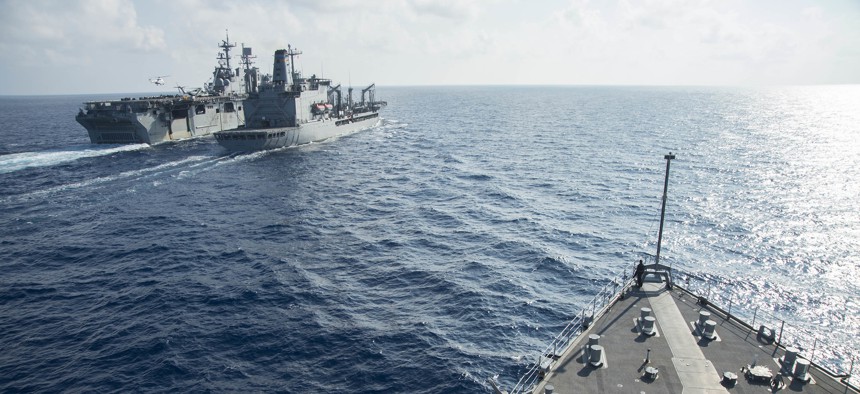
The Whidbey Island-class amphibious dock landing ship USS Germantown (LSD 42) approaches the Military Sealift Command fleet replenishment oiler UNSN Walter S. Diehl (T-AO 193) in the South China Sea in 2016. US Navy / Petty Officer 2nd Class Raymond Diaz III
Use Maritime-Law Trends to Offset Beijing's Gains in the South China Sea
Exploiting changes to the law of the sea can help put China in a place where it has bought much less than it bargained for.
It is sometimes said that China’s construction of man-made islands in the South China Sea resembles the growth of a forest: It expands slowly, but once it has arrived it is difficult to uproot. Yet the law of the sea is changing as well, in ways that might be used to offset Chinese gains.
At this writing, the Subi and Mischief reef installations boast naval bases, runways, hangars, air defenses and communications infrastructure—including jamming equipment. This circumstance presents a widely acknowledged security problem, complicated by overlapping national claims to the area. It is also a challenge to basic freedoms of navigation, since China has objected to U.S. Navy vessels’ innocent passage through what would be those islands’ territorial seas.
As part of their response, the United States and its security partners might take advantage of certain long-term trends in the law of the sea. One such strategy involves the changing nature of sovereignty as practiced by the world’s seagoing nations across various ocean jurisdictions, as I describe in a forthcoming article in the journal Oceans Development & International Law.
To illustrate these long-term trends, consider the Proliferation Security Initiative. Launched in 2004, the PSI was designed by the United States to help interdict WMDs transiting the world’s oceans. Since then, the PSI has grown to include over 100 participating states, each of which adopts a set of limited “interdiction principles.” Although somewhat open to interpretation, the principles imply that the participant nations reserve the right to board offending vessels wherever they are, including—and this is crucial—in the territorial seas of consenting coastal states, in contiguous zones, and during strait transit.
Related: Where is America Going in the South China Sea?
Related: The Arctic Could Be the Next South China Sea, Says Coast Guard Commandant
Related: Defiant Chinese Admiral’s Message: South China Sea ‘Belongs to China’
In this way, the PSI has served as the vehicle for a subtle but distinct change in how the international community administers navigational freedoms. Historically, international law has treated vessels as sovereign islands of their flag state. With few exceptions, only the exercise of port state jurisdiction, or some other territorially-based jurisdiction, could empower a state to board a ship. The PSI represents a shift in these age-old principles: increasingly, states treat a vessel’s individual behavior—like transporting WMDs—as the reason to board it or otherwise interfere with it.
The trend can be seen in the world’s merchant fleet, too. Flag states, and the countries regulating shipowners, have gradually extended their regulation of merchant vessels. As a result, far-flung regulators increasingly dictate what happens aboard vessels, regardless of whether the vessels are on the high seas, in innocent passage, or in a foreign port. Again, the trend is that a vessel’s behavior, rather than its geographic location, increasingly subjects it to a state’s jurisdiction.
Why does this matter? Over time, as individual vessel behavior becomes relatively more important to the administration of navigational freedoms, territorial claims (including those in the South China Sea) correspondingly become relatively less important. Crucially, this trend is driven by state practice all around the globe; it need not occur with any particular intensity in the South China Sea to have an effect there.
This global trend can serve to offset China’s excessive maritime claims in the South China Sea. In building on the Spratlys, one of China’s goals is to use its physical presence, combined with vocal assertions of sovereign control, to influence navigation in the region. But the long-term trends tend to undermine the importance of such territorially-based control. Therefore, one offset method would be to acknowledge, harness, and potentially accelerate these trends. The U.S. could do so by continuing to support multilateral security efforts, like the PSI, that emphasize vessel behavior, and by encouraging states and international organizations to enhance their oversight of vessels’ behavior across the ocean zones.
Of course, these trends cannot negate China’s territorial gains. But, combined with containment and other strategies, exploitation of these trends can put China in a place where it has bought much less than it bargained for.
Like forest growth, these trends in the law of the sea will be gradual. But each year that the forest expands, it will become only more difficult for any one state to uproot, let alone challenge, the state practices that take hold. As these trends continue, the U.S. can offset the excessive maritime claims in the South China Sea while safeguarding navigational freedoms.



